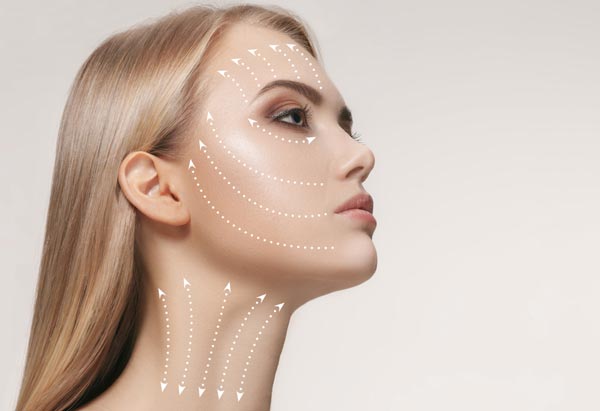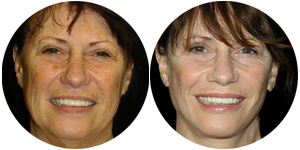Injectable Tissue Replacement ITR2 (ITR squared)
Conveniently located to serve the areas of San Diego, CA

Injectable Tissue Replacement and Regeneration (ITR2) is a revolutionary new facial fat grafting technique that reverses many of the common signs of facial aging. During a facial fat grafting procedure, a surgeon uses the patient’s own fat from elsewhere on their body to plump and volumize facial tissues lost over time. ITR2 is based on scientific understanding of not only the anatomy of facial bone structure, but also, the deep and superficial pockets of facial fat and how they change over time. (1) Cohen Injectable Facial Regeneration™ treatments allow discerning patients the ability to take advantage of his vast knowledge and expertise and achieve results that are truly like none other.The treatment replaces lost facial tissues effectively, meaning patients can regain a more youthful, deeply revitalized facial aesthetic!
It is the task of the plastic surgeon to assess the topography of a patient’s face, determine the underlying tissue loss, and skillfully restore vitality and volume. For the very latest facial revitalization treatments and an expert approach, you can rely on Faces+! As a pioneer of ITR2 technology, and a world-renowned researcher in facial aging, Dr. Steven R. Cohen is at the forefront of cosmetic facial rejuvenation procedures. Book your personal consultation with one of San Diego’s most prominent and respected plastic surgeons in the field! Call (858) 453-7224 or contact us via our online inquiry form to find out more information about the advanced facial fat grafting of ITR2!
Contents
About ITR2
ITR2 facial fat grafting can address the following issues:
- Supraorbital hollowing (hollowing of the eyes)
- Forehead hollowing (loss of tissue volume)
- Deep lines of the forehead and glabella (between the eyebrows)
- Sunken temples (temporal hollowing)
- Tear trough deformity and/or deep nasojugal groove
- Swollen eye bags (Malar bags)
- Nasolabial folds (lines that extend from nose to mouth)
- Marionette lines (deep lines adjacent to the mouth)
- Volume loss in the lips
- Undefined jawline contour (weak chin)
How Does Facial Fat Grafting Work?
Fat is a crucial structural support to the face. Skin and tissue aging occurs due to a number of intrinsic and extrinsic factors which can lead to a decrease in ft in certain areas. Intrinsic factors are those that are inevitable and unable to be controlled, such as genetics. Extrinsic factors are external factors such as sun exposure, air pollution, smoking, and diet. These effects can make your face look gaunt and tired. Therefore, age-associated soft tissue changes require surgeons to augment and improve volume.
A facial fat graft restores volume to the cheeks, lips, eyes, and other areas of the face. It also resuspends tissues that droops, and removes redundant tissue.(2) In medicine, fat is known as adipose tissue. It is mainly composed of fat cells called adipocytes which function to store calories in the form of glucose and fatty acids. In facial fat grafting, a surgeon harvests fat from another area of the body such as the abdomen, thighs, buttocks, or another predetermined area. Autologous adipose tissue is the ideal filler material for facial rejuvenation, as it is biocompatible, has a low risk for allergic reaction, and produces a soft and natural result. (3)
Additionally, the fat harvested from the patient’s body contains valuable stem cells. These remarkable cells can develop into healthy new fat cells to rejuvenate the area of treatment.
What Does Facial Fat Grafting Do?
Facial fat grafting can renew your facial contour and leave it looking fresh, plump and rejuvenated. ITR2 replaces atrophied tissues of the face using “like tissues” to delay or slow the rate of tissue decay seen in facial aging. It is vitally important to place the fat in proper sized grafts into the correct anatomical areas of loss. Therefore, the grafts in an ITR2 procedure are refined using a special device into different sized “parcels” before their reintroduction into the body. It is then categorized in three ways:
Millifat
Dr. Cohen uses millifat to fill areas of loss in the deep fat pockets close to the bone structure of the face. It can also treat the aging nose and age-related displacement of the eye (senile enopthalmos). It is the least filtered tissue. These parcels are 2.0-2.4mm (0.08-0.09in) in diameter.
Microfat
Microfat parcels are 1-1.2mm (0.04-0.05in) in diameter and in the mid-range of filtration. These parcels of adipose tissue are used to fill more superficial fat compartments in facial structures. It is particularly effective when injected into tear troughs.
Nanofat
Finally, the most refined parcels are called nanofat. They are between 400-600 microns in diameter! That’s just 0.015-0.023 inches! These are for the regeneration of intradermal (between layers of skin) and epithelial tissue thinning. Epithelial cells form a matrix to protect and cover surfaces in the body. Your skin is composed of several different types of epithelial cells, each with their own shape and function throughout both superficial and deep layers of the epidermis and dermis.
Benefits
ITR2 advanced facial fat grafting is an effective anti-aging treatment. Many doctors believe it is superior to dermal fillers because it is a more natural way to achieve results, and there is less likelihood of unexpected reactions in patients. ITR2 facial fat grafting:
- Can significantly restore facial volume
- Can address bone loss and deep tissues
- Is a biocompatible, natural rejuvenation option
- Improves skin texture and tone
- Reduces wrinkles and lines
- Has fewer risks and side effects than facial fillers (3)
The results of ITR2 treatment are long-lasting; up to three or four times the length of traditional synthetic fillers. (4)
Candidates for Facial Fat Grafting

The ITR2 procedure is a state-of-the-art method of harvesting and filtering fat. It is suitable for patients between the ages of 30-65 who are looking to reduce signs of aging in their face. Generally, patients should have no underlying conditions that could affect the success of their treatment, and be in good overall health. Facial fat grafting is one of the best ways to address deep wrinkles that have been otherwise resistant to treatments such as Botox. Additionally, patients with hollowing of the eyes may find this is their dream solution!
If you have extensive burn scars, eyelid retraction, metabolic lipid disorders, keloids (raised scar tissue), excessive bleeding disorders, or a history of vascular disease such as deep vein thrombosis, an ITR2 treatment may not be a good match.
Find out for yourself what Dr. Cohen’s groundbreaking facial fat transfer treatment can do for you! Book a personal consultation with him to take your next step toward facial rejuvenation. Contact our San Diego offices at (858) 453-7224 or complete an online inquiry form to get started!
Find out more about facial fat transfer, injectable tissue replacement, and other services on our blog!
Personal Consultation
Dr. Cohen creates a personalized ITR2 treatment plan for each patient based on areas of bone and fat loss and skin thinning. (1) At your personal consultation you will have the chance to speak to him about your individual needs, and the specific problems you are facing with regard to facial aging. He will walk you through the basics of his unique facial fat transfer process, and tell you how the ITR2 treatment can target specific areas of your face for rejuvenation.
If you are receiving facial fat grafting as a standalone treatment, this procedure may require local anesthesia. However, some patients choose to combine procedures! Other surgeries such as brow lift, jaw augmentation, and California Facelift may require general anesthesia. Dr. Cohen will assess whether ITR2 is a good fit for your situation, we will schedule your procedure appointment for the coming weeks.
Preparation
To prepare for facial fat grafting, Dr. Cohen advises his patients to be at or near their desired weight, so fat can be harvested successfully. It may be advisable to arrange a week or so off work with your employer for optimal recovery. If you smoke, you will need to avoid nicotine products entirely six weeks prior, and in the weeks after your procedure. You should stop taking certain medications, such as blood thinners (ibuprofen, Advil, Plavix, as these can increase bruising and increase bleeding in the area(s) of treatment. Please discuss your current medications with Dr. Cohen at your personal consultation.
The ITR2 Procedure
After a local anesthetic is administered, and to begin the facial fat transfer process, Dr. Cohen administers a wetting solution with a cannula and syringe and removes fat from the donor area through a tiny incision. This is often made through the navel for easy access if the tissue is from the abdomen. Next, the harvested adipose tissue is carefully filtered in a special machine through three stages:
- Sedimentation (using gravity to separate the constituent parts of the fat)
- Centrifugation (mechanical agitation)
- Washing and filtering.
In this way, Dr. Cohen resizes tissue from millifat into microfat and finally nanofat. After the tissue has been resized, your fat is carefully reintroduced to specific target areas to rejuvenate and volumize your face!
Recovery After Facial Fat Grafting

ITR2 treatments take place under local or general anesthesia. After your procedure is complete, you may experience temporary mild to moderate facial discomfort. Dr. Cohen can prescribe oral pain relief for this. Fat transfer recovery varies from patient to patient but generally, you should take 7-10 days off work to heal in a peaceful environment, and limit activity in the coming days. If you are combining facial fat transfer with another procedure, your recovery period may be extended.
Results of ITR2 Treatment
The advanced technology behind the ITR2 procedure makes this advanced form of fat grafting efficient, effective and offers long-lasting natural-looking rejuvenation. Long-term tissue regeneration continues long after a facial fat transfer procedure is complete. Dr. Cohen describes this process as “tropism.” Initial healing takes place in a few weeks, but most patients will realize their final results within six months of their treatment.
Cost of ITR2 Fat Grafting in San Diego
Dr. Cohen individualizes each ITR2 facial fat grafting procedure. Each treatment is carefully tailored to meet your individual rejuvenation goals! Additionally, many of our patients use facial fat grafting to augment another procedure such as a facelift or eyelid enhancement. As a result, the cost of your treatment may vary. Get in touch with our office for more information at (858) 453-7224.
Stay connected with Faces+! Join us on TikTok, Facebook, Instagram, and Twitter. Alternatively, you can check out some of Dr. Cohen’s videos on YouTube. You can also keep an eye on our seasonal specials on our website!
FAQ
How long does injectable tissue grafting last?
Depending on the area of treatment, and your individual situation, the results of a fat grafting procedure can last for many years!
Can I get other procedures at the same time as facial fat grafting?
Yes! Many patients choose to fight signs of aging in one fell swoop! By combining treatments such as ITR2 and facelift, eyelid lift (blepharoplasty), or cheek augmentation, patients can reach their beauty goals quickly and effectively!
Why is fat grafting better than fillers?
Fat grafting techniques use a patient’s own fat from their abdomen, buttocks or thighs to volumize and rejuvenate their face. Many surgeons believe fat grafting is better than fillers because it is natural tissue, and there is a lower risk of complications such as allergic reactions to treatment. (3)
References
- Cohen, S. R., & Womack, H. (2019). Injectable Tissue Replacement and Regeneration: Anatomic Fat Grafting to Restore Decayed Facial Tissues. Plastic and Reconstructive Surgery Global Open, 7(8), e2293. https://doi.org/10.1097/GOX.0000000000002293
- Schultz, K. P., Raghuram, A., Davis, M. J., Abu-Ghname, A., Chamata, E., & Rohrich, R. J. (2020). Fat Grafting for Facial Rejuvenation. Seminars in Plastic Surgery, 34(01), 030–037. https://doi.org/10.1055/s-0039-3402767
- Vasavada, A., & Raggio, B. S. (2021). Autologous Fat Grafting For Facial Rejuvenation. PubMed; StatPearls Publishing. https://www.ncbi.nlm.nih.gov/books/NBK557860/
- Fontdevila, J., Serrarenom, J., Raigosa, M., Berenguer, J., Guisantes, E., Prades, E., Benitoruiz, J., & Martinez, E. (2008). Assessing the Long-Term Viability of Facial Fat Grafts: An Objective Measure Using Computed Tomography. Aesthetic Surgery Journal, 28(4), 380–386. https://academic.oup.com/asj/article/28/4/380/232936



